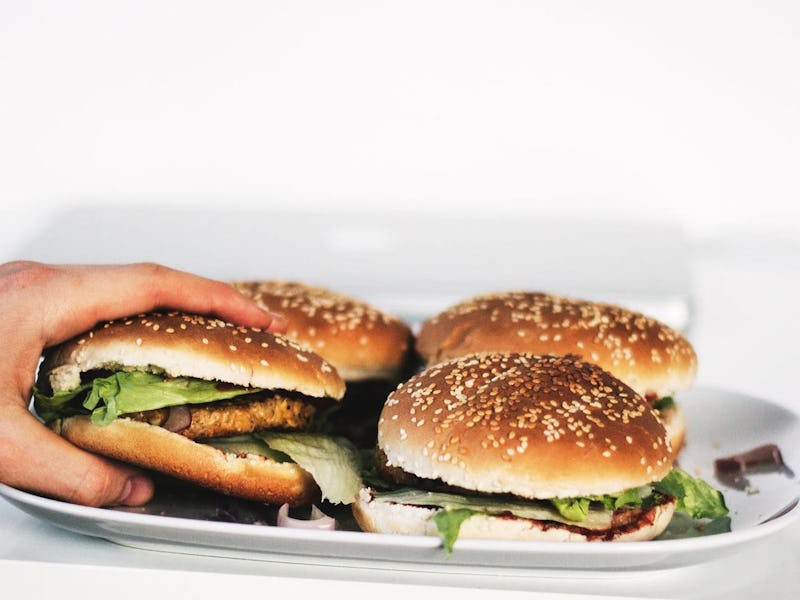With One Food Swap, Your Daily Dietary Carbon Footprint Shrinks 48 Percent
"It would be equivalent to about 3,700 miles driven by an average passenger vehicle."

To stem the climate crisis, humanity has to tackle some big issues, like producing sustainable energy and developing efficient food systems. But even smaller changes, over time, add up. Research presented Monday at the 2019 Nutrition Conference in Baltimore shows that if we all make a single substitution in our daily diets, we can cut our dietary carbon footprint nearly in half.
"…it would be equivalent to about 3,700 miles driven by an average passenger vehicle.”
Methane byproducts from the beef industry constitute a major chunk of the greenhouse gases accumulating in the atmosphere, and it is clear that reducing the demand for beef is ultimately key. Plant-based and lab-grown meat are gaining ground as beef substitutes, but for environmentally conscious people who aren’t ready to embrace the new Impossible Whopper, agricultural economist Diego Rose, Ph.D., argues that a single baby step can drive powerful change.
According to Rose, a simple mealtime substitution can make a big difference: Tonight, when you’re thinking about what to eat for dinner, consider swapping out beef for poultry. That swap, he says, can reduce diet-related greenhouse gas emissions per day by a very significant amount.
“The reduction in their dietary carbon footprint of 48% would occur on any day that they substituted poultry for beef,” he says. “So it’s a daily figure, but it would happen for as long as they did it.”
If each person swapped out beef for poultry for one meal per day, Rose estimates that they could reduce their individual carbon emissions by 48 percent.
These daily small steps could build up to something very powerful. “For each person, if this type of change was made on every day of the year, it would be equivalent to about 3,700 miles driven by an average passenger vehicle,” he continues. “We knew it would be lower, but we were surprised about how much of reduction there was from just one simple change.”
Rose’s conclusions are based on the predictions of a model he developed based on the dietary habits of 16,800 Americans. Each of those people listed the foods they ate in 24 hours as part of the National Health and Nutrition Survey. Using the model, Rose made a hypothetical swap: replacing one beef-based item per person with a poultry-based one.
“So one substitution means that we substituted one food — either a cut of beef or ground beef — for an equivalent poultry product. For example, chicken for steak, ground turkey for ground beef,” he explains. “If a respondent ate a steak, fries, and salad for dinner, we substituted the steak for an equivalent calorie amount of chicken, but left the fries and salad.”
Overall, roughly 20 percent of the participants had eaten beef or ground beef in the 24-hour survey period. According to the model, swapping out just one of those beef-based items made a world of a difference.
This change is just one small one we can make to supplement other efforts to reduce carbon emissions overall. It’s important to remember that Rose’s data are related to dietary emissions — not emissions from other activities, like car or airplane travel. All of these factors have played a role in the recent climate crisis landmarks that humanity has blown through lately, including the highest monthly CO2 average. ever recorded.
Nevertheless, in a world where climate problems can feel systemic and out of our control, Rose’s work is a nice reminder that our choices do have gravity — even small ones that feel incredibly doable.
Partial Abstract:
Methods: Based on an extensive review of lifecycle assessment studies in the environmental sciences literature, we created a database of Food Impacts on the Environment for Linking to Diets (dataFIELD). We matched impact data from dataFIELD to the 24-hour recall dietary data in the 2005-2010 waves of the National Health and Nutrition Examination Survey (NHANES). For all adults with reliable diets (N=16,800), we calculated their dietary carbon dioxide equivalents per 1000 kcal (kg CO2-eq 1000 kcal-1), a density measure of GHGE. A 10% random sample (N=330) of all diets in the top quintile of this variable was selected. The single food item with the highest GHGE was identified in each of these high-impact diets and was substituted for an equal-calorie amount of a similar, but lower impact food (e.g. chicken for beef). Each of the 330 diets were then re-evaluated on total GHGE/1000 kcal and on the Healthy Eating Index, a summary measure of nutritional quality developed for the U.S. population.
Results: The food with the highest impact in each of the randomly chosen diets was most often a type of beef (52%), a mixed dish with beef (33%), or a shellfish/shellfish mixed dish (10%). After single-item substitutions were made for these foods with equivalent poultry-based items, the mean impact from this sample of diets dropped (p < .001) from 4.35 ± 0.1 to 1.95 ± 0.8 kg CO2-eq 1000 kcal-1. This represents a 54% reduction in average dietary greenhouse gas emissions from diets. Healthy Eating Index values for the revised diets showed slight improvements.
Conclusions: Simple substitutions can be made in individuals’ diets to reduce their carbon footprints, without sacrificing dietary quality. If promoted on a wide-scale basis, such a strategy could substantially reduce greenhouse gas emissions from the U.S. diet.